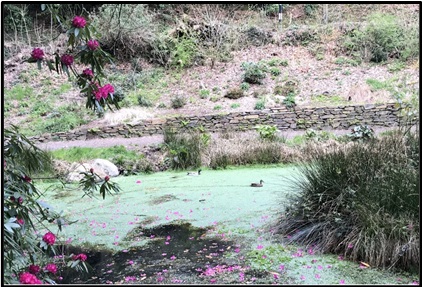
July 7, 2021, by Lexi Earl
Duckweed hunting in the South West: Part two in a botanical tale of exploring natural variation around us
This post is written by Kellie Smith
I introduced the great duckweed hunt in my previous blog starting on the South East coast. The quest takes me this week to the other end of the South, the South west corner, particularly St Austell and the Cornwall region. It turns out Cornwall is quite far!
Why Cornwall?
Cornwall is considered to be an entry point to the UK for migrating duckweeds, so species distribution and characteristics must be understood here. The earlier in the annual season we can find them the better, to catch thriving/offending species in the act! My initial impressions suggest the presence of duckweed seems improbable here. Streams are fast flowing, making conditions a bit more unsuitable for establishment. The few duckweeds in these types of water courses are difficult to see or reach; however stagnant ponds or those contaminated with metals offer potentially useful duckweed sites.
St Austell and surroundings have a history of first tin mining and then China clay extraction through quarrying activities. These have released aluminosilicates and other minerals and it would be useful to see where these have gone. The mining history is visible from the landscapes of peaks and Mika-containing pools. Some mining still goes on today on privately-owned land, however the surrounding landscape is formed of clay trails and mill ruins. Clay trail areas including Tregargus valley ruins had ditches and a waterwheel both colonized with duckweed! Such sites and the Menacuddle pond in the heart of the mining areas had high duckweed density and more acidic waters. pH analysis in the field is only one of the weapons to understand duckweed environmental pressures. The Ionomics facility of the Future Food Beacon are able to succinctly analyse both habitat water mineral content and the ion composition of the duckweeds attributed to each area. All 100+ accessions of the UK-wide panel are being grown in common environments to see if we can identify tolerant species and those which may have nutritional benefits, for example if they are high in magnesium or iron.

Beautiful clay-bottomed pond at the heart of the clay trails, Menacuddle well, St Austell. One would never know not five years ago it was covered in laurel and did not support any life. Now it is supporting moderate laurel coverage interspersed with duckweed. It is home to wild ducks and flying insects. “Now the pond is teeming with life — with frogs, toads, newts, beetle, damsel and dragonflies in abundance”-http://wwww.menacuddlewell.co.uk
The pond is snuggled by rhododendrons and floral litter, with reeds, ferns, and cedars surrounding it, making it a colourful scene indeed.
One cannot ignore the numerous other beautiful gardens and estates in the Cornwall area.

Pot of duckweeds, Trewithen gardens, Truro (left). Duckweeds lining up at the edge of a koi pond in the Japanese garden, St Mawgan (right).
One perk of the hunt is the ability to talk to the local people, organizations, charities and owners when organizing access to different places, and also to gain understanding of public perceptions of duckweed. We had the opportunity to talk to the pond management team at the Lost Gardens of Heligan. While initially just seeking access for a duckweed sample and data from their most established pond, it gave us a great opportunity to learn about the duckweed clearance techniques the team use later in the year, including raking the surface and wading the water in wetsuits. We can also use their series of established ponds and those in production as a ‘timeline’ of water profiles associated with existing duckweed populations compared with ponds in management or lacking duckweeds at the present time.

Jungle pond, Lost Gardens of Heligan: a charming jungle garden boasting duckweeds and the New Zealand invasive aquatic fern Azolla, as well as water hawthorne, ferns, rhododendrons and mangroves.
Join me again next week for the next locations of interest in the South West, in particular Bristol and Newport as sample sites to give a flavour of both English and Welsh duckweeds.
No comments yet, fill out a comment to be the first

Leave a Reply